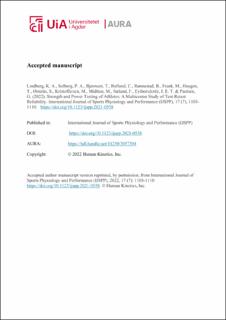| dc.contributor.author | Lindberg, Kolbjørn Andreas | |
| dc.contributor.author | Solberg, Paul Andre | |
| dc.contributor.author | Bjørnsen, Thomas | |
| dc.contributor.author | Helland, Christian | |
| dc.contributor.author | Rønnestad, Bent | |
| dc.contributor.author | Frank, Martin | |
| dc.contributor.author | Haugen, Tommy | |
| dc.contributor.author | Østerås, Sindre | |
| dc.contributor.author | Kristoffersen, Morten | |
| dc.contributor.author | Midttun, Magnus | |
| dc.contributor.author | Sæland, Fredrik | |
| dc.contributor.author | Eythorsdottir, Ingrid Eir Thorp | |
| dc.contributor.author | Paulsen, Gøran | |
| dc.date.accessioned | 2023-03-09T11:20:03Z | |
| dc.date.available | 2023-03-09T11:20:03Z | |
| dc.date.created | 2022-08-17T11:27:55Z | |
| dc.date.issued | 2022 | |
| dc.identifier.citation | Lindberg, K. A., Solberg, P. A., Bjørnsen, T., Helland, C., Rønnestad, B., Frank, M., Haugen, T., Østerås, S., Kristoffersen, M., Midttun, M., Sæland, F., Eythorsdottir, I. E. T. & Paulsen, G. (2022). Strength and Power Testing of Athletes: A Multicenter Study of Test-Retest Reliability. International Journal of Sports Physiology and Performance (IJSPP), 17 (7), 1103-1110. | en_US |
| dc.identifier.issn | 1555-0273 | |
| dc.identifier.uri | https://hdl.handle.net/11250/3057304 | |
| dc.description | Author's accepted manuscript | en_US |
| dc.description | Accepted author manuscript version reprinted, by permission, from International Journal of Sports Physiology and Performance (IJSPP), 2022, 17 (7): 1103-1110, https://doi.org/10.1123/ijspp.2021-0558. © Human Kinetics, Inc. | |
| dc.description.abstract | Purpose:This study examined the test–retest reliability of common assessments for measuring strength and power of the lowerbody in high-performing athletes.Methods:A total of 100 participants, including both male (n=83) and female (n=17) athletes(21 [4] y, 182 [9] cm, and 78 [12] kg), were recruited for this study, using a multicenter approach. The participants underwentphysical testing 4 times. Thefirst 2 sessions (1 and 2) were separated by∼1 week, followed by a period of 2 to 6 months, whereasthe last 2 sessions (3 and 4) were again separated by∼1 week. The test protocol consisted of squat jumps, countermovementjumps, jump and reach, 30-m sprint, 1-repetition-maximum squat, sprint cycling, and a leg-press test.Results:The typical error(%) ranged from 1.3% to 8.5% for all assessments. The change in means ranged from−1.5% to 2.5% for all assessments, whereasthe interclass correlation coefficient ranged from .85 to .97. The smallest worthwhile change (0.2 of baseline SD) ranged from1.2% to 5.0%. The ratio between the typical error (%) and the smallest worthwhile change (%) ranged from 0.5 to 1.2. Whenobserving the reliability across testing centers, considerable differences in reliability were observed (typical error [%] ratio: 0.44–1.44).Conclusions:Most of the included assessments can be used with confidence by researchers and coaches to measurestrength and power in athletes. Our results highlight the importance of controlling testing reliability at each testing center and notrelying on data from others, despite having applied the same protocol. | en_US |
| dc.language.iso | eng | en_US |
| dc.publisher | Human Kinetics | en_US |
| dc.title | Strength and Power Testing of Athletes: A Multicenter Study of Test-Retest Reliability | en_US |
| dc.type | Peer reviewed | en_US |
| dc.type | Journal article | en_US |
| dc.description.version | acceptedVersion | en_US |
| dc.rights.holder | © 2022 Human Kinetics, Inc. | en_US |
| dc.subject.nsi | VDP::Medisinske Fag: 700::Idrettsmedisinske fag: 850 | en_US |
| dc.source.pagenumber | 1103-1110 | en_US |
| dc.source.volume | 17 | en_US |
| dc.source.journal | International Journal of Sports Physiology and Performance (IJSPP) | en_US |
| dc.source.issue | 7 | en_US |
| dc.identifier.doi | https://doi.org/10.1123/ijspp.2021-0558 | |
| dc.identifier.cristin | 2043777 | |
| cristin.qualitycode | 1 | |
